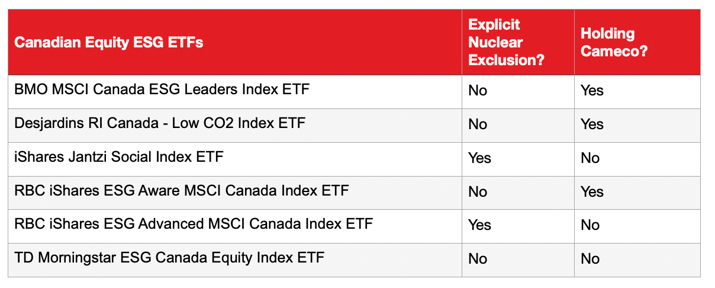
Russia’s invasion of Ukraine and related sanctions have sent fuel prices soaring, threatening energy insecurity around the world. Canada’s economy now faces a two-pronged conundrum: a heightened need for energy security alongside an urgent need to transition away from fossil fuels.
The latest report from the Intergovernmental Panel on Climate Change shows we’re running out of time to transition: Global greenhouse gas emissions must peak and begin a permanent decline by 2025 to keep warming below the Paris Agreement–aligned target of 1.5 °C. There’s no room to build new fossil fuel infrastructure because existing infrastructure already puts us on track to exceed the target.
This raises questions about the role of nuclear power: Can it help us achieve energy security while also driving down emissions? And, for investors interested in sustainability, does nuclear belong in a fund that incorporates ESG issues?
While Europe’s Sustainable Finance Disclosure Regulation allows for nuclear power to be included in funds that are marketed as sustainable, there is no comparable regulation here in Canada. So, it’s up to the market to decide whether nuclear belongs in a Canadian ESG fund.
Nuclear exposure in Canadian ESG funds
An analysis of a small sample of Canadian ESG funds suggests at first glance that the industry is split on nuclear. The table below lists six Canadian equity ETFs that are marketed with an ESG or sustainability focus. Since they’re all Canadian equity funds, the S&P/TSX 60 is a reasonable benchmark, and that index happens to include Cameco, one of the world’s largest producers of uranium used for nuclear power. I scanned each fund’s holdings to see if it includes the Saskatoon, Sask.–based company, and I also checked for an explicit exclusion of companies involved with nuclear power. The findings are in the table below.
Table: Nuclear power inclusion in a sample of Canadian ESG ETFs
Click on the table to enlarge it.
Half of the funds surveyed include Cameco, and of the three funds that don’t, two explicitly exclude companies involved with nuclear power.
One way to interpret this analysis would be to say Canada’s asset management industry is divided. Another would be to say the industry is responding to investor demand, and different investors have different preferences. Since these funds have different ESG strategies and objectives, I lean toward the latter.
Recent green bond issuances reinforce this interpretation. Despite the federal government’s clear support for nuclear power as a key piece of Canada’s net-zero future, nuclear was excluded from its recent green bond issuance along with tobacco, alcohol, gambling, weapons and fossil fuels. Given the federal government’s obvious commitment to nuclear power, I can only speculate that nuclear was excluded as part of an effort to maximize investor demand, since it remains divisive among the ESG set.
That said, Tiverton, Ont.–based Bruce Power became the first to issue a green bond backed by nuclear power generation in December of last year, and there was no shortage of investor demand. The Bruce Power green bond was oversubscribed sixfold, signalling strong investor appetite for nuclear as an important investment opportunity on the road to net zero.
A calculated risk
As uncomfortable as it feels to say out loud, nuclear power is an existing technology that can help achieve the dual objectives of energy security and the transition away from fossil fuels. It’s uncomfortable because it’s a polarizing topic, and because I know that many responsible investors and advisors reject the idea of nuclear in their portfolios. If you are reading this, I see you and I share your concerns about the risks associated with nuclear power generation.
But we must acknowledge that there is no risk-free, emissions-free source of energy capable of powering society as we know it, available at the scale and speed needed to ramp down emissions within the necessary time frame. Renewables like hydroelectricity, wind, solar, geothermal and hydrogen alone can’t put us on track to a net-zero economy in the next few years. Nuclear can step in to meet baseload energy demand immediately while renewable technologies develop and scale up.
The potential risks of nuclear power generation are indeed significant. The main risks are reactor accidents, as we learned from the disasters at Chernobyl and Fukushima, as well as radioactive waste management. There are also risks associated with proliferation more broadly. However, these risks are known and thus far more manageable than the unknown risks of barrelling toward a 3 °C world, which looks probable according to modelling from Climate Action Tracker.
It should be noted that nuclear catastrophes are exceedingly rare. The International Nuclear and Radiological Event Scale, which tracks the severity of nuclear incidents and accidents dating back to the 1950s, has identified only three events that qualify as “major” or “severe” accidents. These include the disasters at Chernobyl and Fukushima, and one in the former Soviet Union. There have been dozens of smaller incidents as well, most of which occurred in the 20th century. These historical nuclear disasters shouldn’t be dismissed but need to be put in context.
According to a peer-reviewed academic study, historical fatalities from nuclear accidents pale in comparison to fatalities from other energy-related accidents. Between 1800 and 2018, there were 4,856 deaths from 178 nuclear accidents. Over the same time frame, there were 187,227 deaths from 160 hydro accidents, 26,215 deaths from 890 oil accidents, and 55,414 deaths from 2,428 coal accidents.
The authors also used historical data to project future deaths from energy-related accidents to 2040 in the International Energy Agency’s “sustainable development scenario,” which accounts for greater use of nuclear and other low-carbon sources of energy. They found that the technologies projected to have the most fatal future energy accidents are solar (1.3 million fatalities by 2040), hydroelectricity (333,285 fatalities), and bioenergy and geothermal (70,904 fatalities). In contrast, nuclear accidents are projected to cause just 5,483 fatalities in the same time horizon.
Furthermore, the World Health Organization (WHO) forecasts that between 2030 and 2050, climate change will cause approximately 250,000 additional deaths per year from malnutrition, malaria, diarrhea and heat stress.
So, the health-risk trade-off is asymmetrical, with far more deaths projected from climate change and other sources of energy than from nuclear.
While none of these deaths are acceptable, we need to recognize that no energy comes without risk. We live in a world of trade-offs, and we need to take calculated risks.
The province of Ontario took a calculated risk in betting on nuclear, and in doing so it became the first North American jurisdiction to eliminate coal-fired electricity. In 2003 coal represented 25% of Ontario’s supply mix; by 2014 it was down to 0% as the province ramped up its nuclear capacity and improved grid reliability in the process. Today, about 60% of Ontario’s power needs are met by nuclear, and its rapid transition from coal to nuclear stands as the largest emissions reduction action on the continent, helping Ontario achieve its 2014 emissions reduction target of 6% below 1990 levels. There have been no major accidents.
Conclusion
Can we rely on nuclear power forever? Probably not. We can’t stuff Earth’s crust with radioactive waste, just as we can’t stuff it with captured carbon; neither is sustainable. But given the climate emergency, both are needed to course-correct our trajectory — at least for a transition period.
Does nuclear belong in ESG funds? It depends on the fund’s objective. If the fund caters to investors who wish to exclude a basket of industries they find objectionable, then by all means there appears to be a market for that.
But if the fund aims to reduce exposure to carbon and/or finance the transition to a net-zero economy, then there is a strong case for having exposure to nuclear power. Leading asset managers would go a step further and supplement these holdings with stewardship activities to ensure strong governance, safe waste-management practices, and free, prior and informed consent and engagement with Indigenous and other communities that could be affected.

